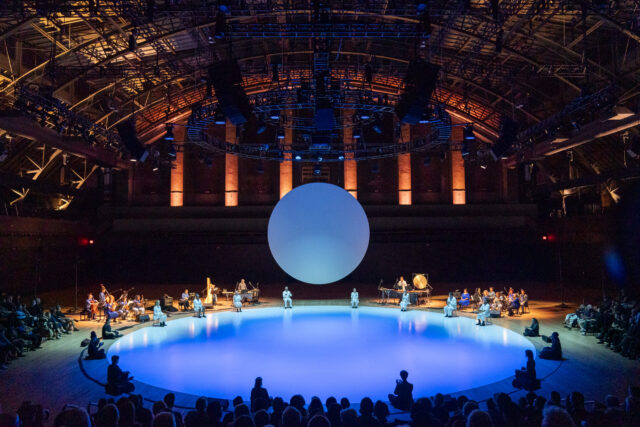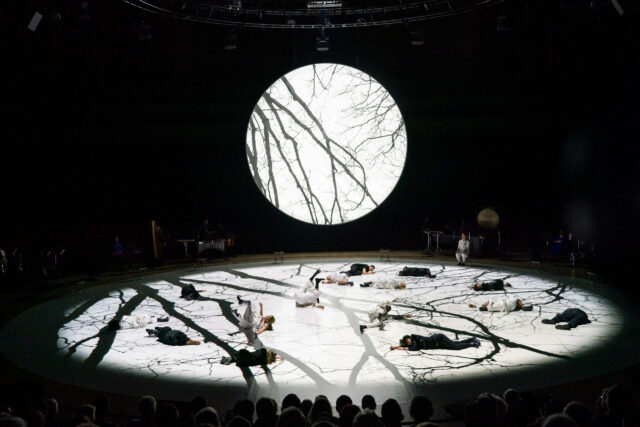
Meredith Monk’s Indra’s Net at Park Ave. Armory is a multimedia marvel (photo by Stephanie Berger)
INDRA’S NET
Park Avenue Armory, Wade Thompson Drill Hall
643 Park Ave. at 67th St.
Through October 6, $45-$185
212-933-5812
www.armoryonpark.org
Meredith Monk, the grand doyenne of experimental music, theater, film, and dance, completes her trilogy exploring the interconnectedness of humanity and the natural environment and the universe with the gorgeous Indra’s Net, making its North American premiere at Park Ave. Armory through October 6. The eighty-one-year-old MacArthur Fellow and National Medal of Arts honoree began the three-part work with 2013’s On Behalf of Nature, followed by 2017’s Cellular Songs. Conceived for the armory’s massive Wade Thompson Drill Hall, The piece starts with a preamble; as the audience enters the space, they are greeted by “Rotation Shrine,” projections of Monk and members of her vocal ensemble in silhouette, their bodies floating across the screen. Meanwhile, four dancers to the right and four to the left pose in spotlights as droning music plays.
The audience is then seated in rafters around a large circle on the floor with eight small chairs lined horizontally in a row; at the east end of the hall is a moonlike flat screen hovering above the performance space, facing the audience, its curved upper limit mimicking the arched ceiling. The eight dancers (Tomas Cruz, Jodi Gilbert, Toussaint Jeanlouis, Anaïs Maviel, Luisa Muhr, Paul Pinto, Sarah Rossy, Chanan Ben Simon), known as the mirror chorus, take seats on cushions along the outer edge of the circle, then Monk and the vocal ensemble (Paul Chwe MinChul An, Theo Bleckmann, Gideon Crevoshay, Allison Easter, Ellen Fisher, Katie Geissinger, music supervisor Allison Sniffin) sit on the chairs. They move their arms and legs in synchronized motion to begin the piece as the sixteen-piece orchestra, eight on each side and dressed in shades of blue, perform the lovely score, led by Fifi Zhango on piano, Laura Sherman on harp, Ethan Cohn on double bass, Michael Raia on clarinet, and Karl Ronneburg and John Hollenbeck on percussion.
It’s no mere coincidence that the cast is made up of groups of eight, a number that, in various mathematical, religious, mystical, and numerological meanings, represents regeneration, prosperity, and the search for balance between the spiritual and material worlds.
Soon the vocal ensemble is wandering the stage, breaking off into duets and trios as if they are having conversations, although no actual words are spoken, instead creating their own language. Occasionally, a live overhead camera projects the movement on the screen, providing breathtaking visuals. At one point, the vocal ensemble, in all white, and the mirror chorus, in all black, interact as projections of tree branches evoking arteries appear on the floor and screen, interweaving humans with nature. The costumes and set are by Yoshio Yabara, with whispery, echoing immersive sound by Daniel Neumann, evocative, sometimes spooky lighting by Joe Levasseur, mesmerizing cinematography by Ben Stechschulte, and engaging projections by Jorge Morales Picó.

Meredith Monk completes eleven-year trilogy with dazzling Indra’s Net (photo by Stephanie Berger)
In the program, Monk explains that the title of the eighty-minute piece, Indra’s Net, comes from an “ancient Buddhist/Hindu legend [in which] an enlightened king, Indra, stretches an immense, boundless net across the universe with an infinitely faceted jewel at every intersection. Each jewel is unique yet reflects all the others, illuminating the principle of interdependence among all living things.”
Metaphorically, the net and jewels refer to the interdependence between the performers and the audience, celebrating each individual, but on the way out after the show it morphs into a poetic reality as the audience encounters “Offering Shrine,” a video of sixteen people, including many of the vocalists and dancers, opening their hands to reveal such objects as a baseball, keys, a toy car, Scrabble letters, and animal sculptures, representations of which are arranged on a long table below the screen. It’s a compelling way to pay tribute to the little things that, together, help shape an existence that encircles us all.
[Mark Rifkin is a Brooklyn-born, Manhattan-based writer and editor; you can follow him on Substack here.]